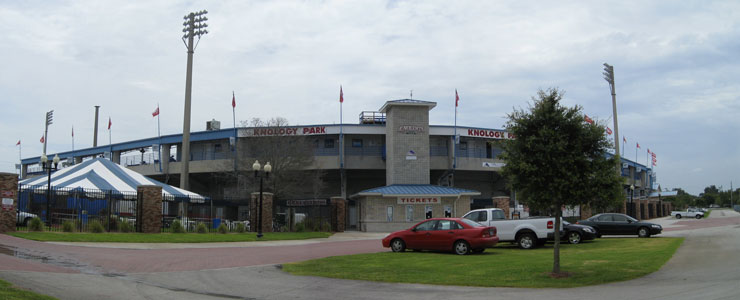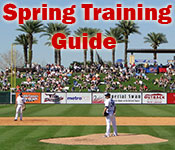
|
In 2002, Dunedin Stadium was ranked by Sports Illustrated as one of the top 5 places to watch a spring training game, a remark that is oft cited in most write ups of the quaint little 5,509-seater.
SI writer Tom Verducci, one of the best scribes in baseball, wrote that the Blue Jays spring training ballpark was one of the best of its kind because of its “old-school charm,” which includes every seat being near the field. While having seats fairly close to the field is a common trait, and part of the appeal, of each spring training ballpark, Dunedin Stadium is fairly unique in its retention of charm, despite major renovations in 1990 and 2002. More than a little charm has been lost as stadiums in Arizona and Florida have been renovated, rebuilt or opened over the past two decades, but charming is an adjective that still applies to Dunedin Stadium. Part of that has to do with its residential location and the fact it is actually a community ballpark, serving as the home field to the local high school powerhouse baseball team. The Dunedin High School Falcons, Toronto Blue Jays and Dunedin Blue Jays all receive equal billing on the stadium’s brick supported marquee sign. No other local team receives that kind of recognition at a Cactus or Grapefruit League park. Dunedin Stadium is not big, filled with amenities or even traditional stadium seats, as those that fill the grandstand do not fold. Small metal armrests accompany each seat but cup holders do not. All seats are painted blue and so is the roof of the stadium, which covers the top six rows of all upper grandstand seats except for the three sections in front of the press box, which has a blue façade. The same hue of blue colors the roof of the two-story building that wraps around the right field corner. That building houses the Blue Jays’ administrative offices and clubhouse. The visitor’s clubhouse is buried beneath the third base grandstand, which barely extends past the bag. The grandstand on the first base side of the stadium extends well down the right field line.
Pitchers sitting in the visiting team’s bullpen down the left field line require a different kind of protection. They sit under a roll away batting cage that shelters them from the sun. Jays’ pitchers watch from elevated bleachers behind the right field fence, which obscures fans from watching them warm up. The concourse has no view of the playing field. It’s behind and below the grandstand, which is accessed via stairs or a ramp at the edge of the third base grandstand. An electric wheelchair lift is down the right field line. On the concourse fans will find all of the stadium’s concessions, two team shops and a lot of history. Behind home plate a plaque memorializes Tom Cheek, the beloved announcer who called the Blue Jays' first 4,306 games before finally missing one in 2004 and dying the following year.
The grandstand overhangs some of the concourse, which provides covering for the concession stands built into its exterior wall and a fixture to hang banners of numerous Blue Jays greats. Each banner features an action photo of a current or (mostly) former Blue Jay along with his name and number. Eleven such banners hang above the concourse and the players featured change yearly. Picnic tables are set up along the first base concourse and at the covered tent behind home plate, which is home to the Bull Pen Café. Labatt Blue, the top selling Canadian beer worldwide, was once found on tap at the stadium but its availability is now limited to bottles sold at freestanding beer carts. Bud and Bud Light are now the featured draft beers and Budweiser’s reach extends to their sponsorship of the lounge in the third base concourse, which is entirely covered but much more narrow and shorter in length than the first base side concourse. The Budweiser Select Lounge is a full service and air-conditioned bar complete with leather coaches, tabletops and a TV. Nice as it is, fans inside the lounge are cut off from the stadium experience. They can't watch the game in there unless it's on television, which isn't often the case. If you do choose to hang out inside the lounge make sure you exit before the 7th inning stretch so you can hear “Chad the Beer Guy” (real name Chad Stypmann) lead the crowd in the singing of Take Me Out to the Ballgame, which he does with his deep baritone voice from atop the Jays' dugout. While Chad’s booming voice easily reaches many in the grandstand, the stadium’s sound system doesn’t do as good a job considering its inherit advantage, which is partially offset by having all music and announcements emit from speakers that are placed in the outfield. In addition to their poor placement, the quality of the speakers' sound is quite tinny. Before each game the speakers pipe out two National Anthems. Words to both The Star Spangled Banner and O Canada! are at the front of the Jays’ spring training program. The American and Canadian flags fly side by side in right-center field. In left-center stands the stadium’s sole scoreboard, which was hand-operated into the 21st century but is now electronically run from the press box, which also contains a small number of skyboxes. A private balcony is on each side of the press box. They both have movie director style chairs on them, but the balconies are far from glamorous. The stadium’s exterior isn’t much to look at. It's dominated by the grayish concrete of the grandstand’s backside, which is accented with blue from the roof and railings that surround the upper sections. A black iron gate and speckled brick pillars form the stadium’s outer perimeter. Made of light colored brick, the ticket office has but four windows and is adjacent to the main entrance behind home plate. The brick tower centered above the ticket office ads a slight touch of class to an otherwise undistinguished exterior. Dunedin’s stadium is not one that will wow you, but it has impressed the Toronto Blue Jays enough that it’s the only place they’ve ever held spring training. Dunedin has been the winter home of the franchise every year since their inception in 1977 and only three teams (Phillies, Pirates, Tigers) have been in their present spring destinations longer. That stability between franchise and city is a noteworthy addendum in any discourse of Dunedin Stadium, which like the city it resides in is small and homely. Would I rank it as one of the top 5 ballparks in spring training? No, I’d respectively disagree with Mr. Verducci on that. Within seven years of Verducci’s proclamation a dozen spring training ballparks had been built or substantially renovated while two of his choices had been abandoned for good. But the unfortunate fate that befell St. Petersburg and Vero Beach isn’t likely to happen any time soon in Dunedin, where the Blue Jays have a lease to train through at least 2017. That guarantees old-school charm won’t go out of style any time soon.
Location and ParkingDunedin Stadium is not a place you happen upon by accident. It's 20 miles from the nearest Interstate (I-275) and 4½ miles from the closest major highway, US 19. But just because Dunedin is a little off the beaten path doesn't mean the stadium is hard to find. Just take US 19 to Sunset Point Road, go west 3½ miles to Douglas Avenue and the stadium is a mile away. Along the route you'll pass residences aplenty. The stadium is next to the city's public library and the VFW is across the street. The nearby side streets are lined with small homes and Spanish Moss. The location is about as residential as they come. The stadium is near the heart of Delightful Dunedin, the name the Downtown Merchants Association has given their city of 35,000 or so residents. Dunedin's charming downtown is just a mile north of the stadium. Shops, boutiques, galleries, restaurants and pubs are either in downtown or on the short drive or walk to it. Unobstructed views of the waters of the Gulf of Mexico are a short distance from downtown and Dunedin boasts of two world class beaches at its Honeymoon and Caladesi Islands. There is minimal parking available on stadium property. The lot that fronts the stadium has grass spaces and paved lanes but costs 10 bucks to park in. The price and proximity make it a bad deal, as cars that park at the stadium lot, which runs parallel to the first base grandstand, are in foul ball territory. It's better to do what most everybody else does and park at one of the myriad of options available throughout the surrounding neighborhood. Expect to pay around $5 to do so.
Ballpark HistoryDunedin's stadium came to be in 1930 thanks to the oversight of their mayor, Albert J. Grant. Officially dedicated as Grant Field on November 22, 1938, it has hosted spring training as far back as the 1950s, when the San Antonio Missions trained for their Texas League season in Dunedin. In 1977 the small time park had finally reached the big time, as the Toronto Blue Jays choose Dunedin and Grant Field to be their spring training headquarters. The first game in franchise history took place on March 11, 1977. The Blue Jays scored two runs in the eighth inning and that was the difference in their 3-1 victory over the New York Mets. Tickets for the Jays' inaugural season of exhibition games cost $2 and all seats were bleachers. That changed in 1990, when Dunedin spent $2.4 million to upgrade the stadium and the current style of seats were installed in the grandstand. Freestanding bleachers were added down the right field line and capacity expanded to 6,106 (it was previously 3,417). The playing field remained unchanged but the official name of the stadium didn't. On March 3, 1990 it was dedicated as Dunedin Stadium at Grant Field. That was still the name in 2002 when another round of renovations, this one costing $12 million, were completed. The bleachers in right field were removed and replaced by two sections of seating that extended the grandstand well down the right field line. The current ticket office was built, but it had less tickets to sell as the official capacity was reduced to 5,509. The highlight of the renovation was the addition of a two-story L-shaped building in right field. It now houses the Blue Jays clubhouse, administrative offices, weight room and other training facilities. Upon completion of the 2002 renovations, a new 15-year lease for the Blue Jays went into effect. The team also has two five-year renewal options. In 2004, the stadium was given a corporate-backed named after Knology, a Georgia-based telecommunications company, paid $340,000 to rename it Knology Park. When that agreement expired on September 30, 2008, the stadium reverted back to half of its rededicated name, as Grant Field was dropped and the name Dunedin Stadium adopted. But Dunedin's stadium will likely drop the city's name from it in the near future, as they are actively shopping naming rights. In a sign of the times, the city's Web site has posted a Name Our Stadium! brochure for interested parties to peruse. Yes, things sure have changed a lot since Mayor Grant's days.
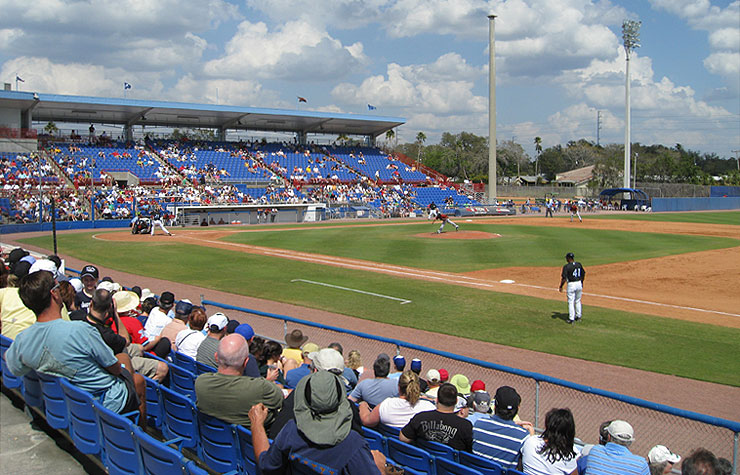
Dunedin Stadium Facts, Figures & Footnotes
| ||||||||||||||||||||||||||||||||||||||||||||||||||||||||||||||||||||||||||||||||||||||||||||||||||||||||||||||||||||||||||||||
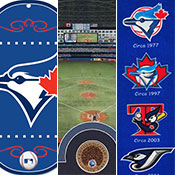

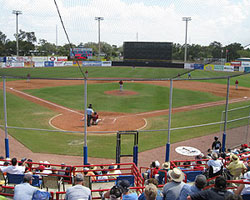 The playing field is close enough to the seats that netting was erected on top of the dugouts to protect those sitting behind them. A backstop with visible supports holds up thicker netting behind home plate. A portable screen is wheeled into place outside of each dugout by game time. Spring training custom dictates that the manager and a couple of his coaches sit outside of the dugout so they can better view the players. The screens are needed so they don’t become an unintended victim of a foul line drive. Batters in the nearby on-deck circle have to fend for themselves.
The playing field is close enough to the seats that netting was erected on top of the dugouts to protect those sitting behind them. A backstop with visible supports holds up thicker netting behind home plate. A portable screen is wheeled into place outside of each dugout by game time. Spring training custom dictates that the manager and a couple of his coaches sit outside of the dugout so they can better view the players. The screens are needed so they don’t become an unintended victim of a foul line drive. Batters in the nearby on-deck circle have to fend for themselves.
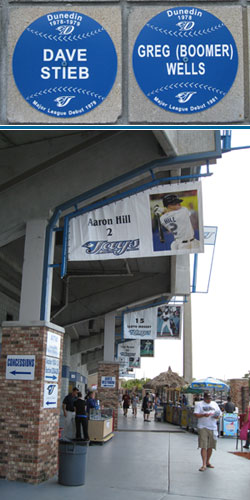 An exhibit in right field entitled “Players From Dunedin To The Show” lists those who did just that on a baseball-shaped marker. Each contains the name of a player, the year or years they played in Dunedin, and the year they made their Major League debut. The Dunedin Blue Jays have been a Class-A affiliate of Toronto since 1978, and four players from that inaugural club advanced to "The Show," the first being Dave Stieb.
An exhibit in right field entitled “Players From Dunedin To The Show” lists those who did just that on a baseball-shaped marker. Each contains the name of a player, the year or years they played in Dunedin, and the year they made their Major League debut. The Dunedin Blue Jays have been a Class-A affiliate of Toronto since 1978, and four players from that inaugural club advanced to "The Show," the first being Dave Stieb.
